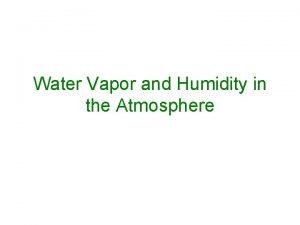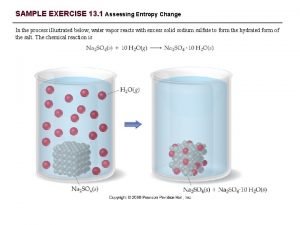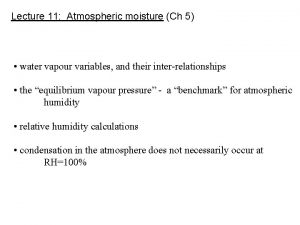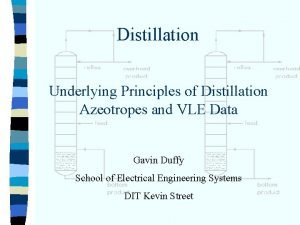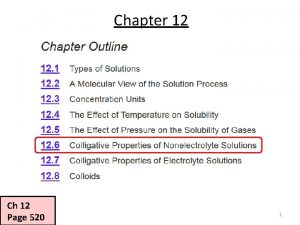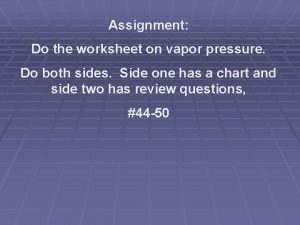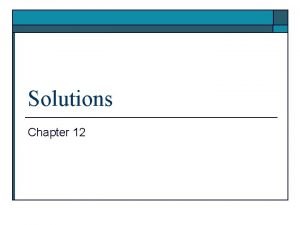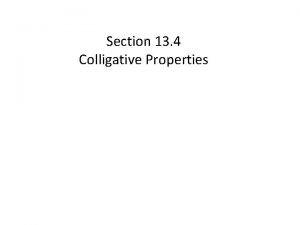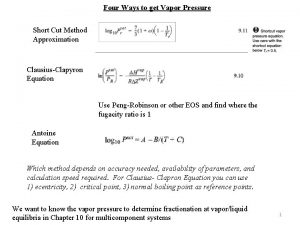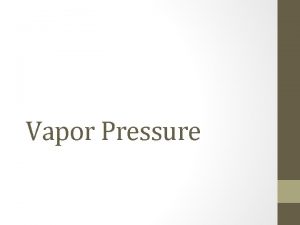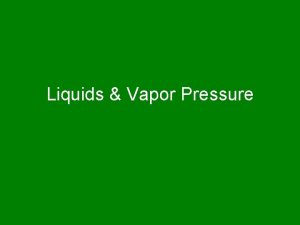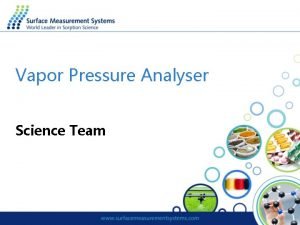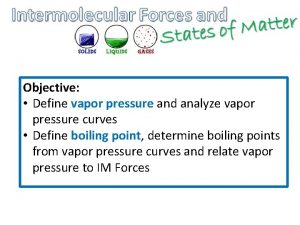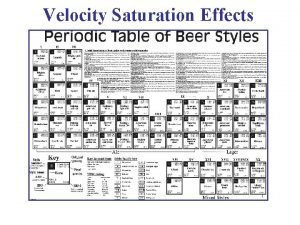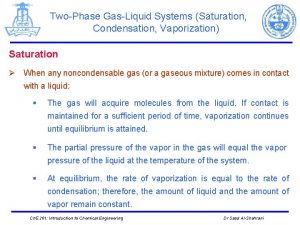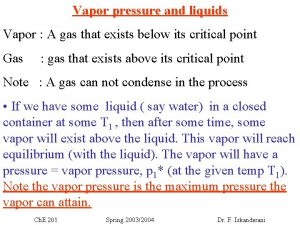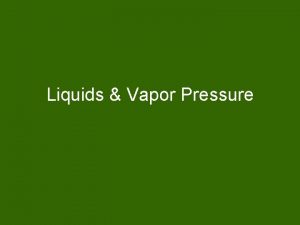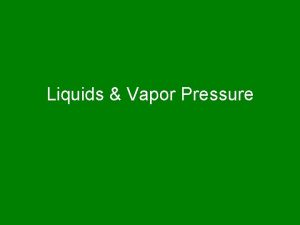Review Vapor pressure e Saturation vapor pressure es

![Review Relative humidity (RH)= [actual vapor pressure/saturation vapor pressure]x 100 Lifting condensation level-the level Review Relative humidity (RH)= [actual vapor pressure/saturation vapor pressure]x 100 Lifting condensation level-the level](https://slidetodoc.com/presentation_image_h2/5b973b082f8a57359baef27072a0e6c8/image-2.jpg)











- Slides: 13

Review Vapor pressure (e) Saturation vapor pressure (es) Saturation vapor pressure over water is larger than over ice because water evaporates more readily than ice. 0 The C. magnitude es-esi reaches a peak value of about – 12 Implication: If an ice particle is in water saturated air, it will grow due to the deposition of water vapor upon it. We will see later that this mechanism is important in the growth of precipitable particles in clouds.
![Review Relative humidity RH actual vapor pressuresaturation vapor pressurex 100 Lifting condensation levelthe level Review Relative humidity (RH)= [actual vapor pressure/saturation vapor pressure]x 100 Lifting condensation level-the level](https://slidetodoc.com/presentation_image_h2/5b973b082f8a57359baef27072a0e6c8/image-2.jpg)
Review Relative humidity (RH)= [actual vapor pressure/saturation vapor pressure]x 100 Lifting condensation level-the level to which a parcel of moist air can be lifted adiabatically before it becomes saturated with respect to a plane surface of water. Wet bulb temperature Tw defined as the temperature to which a parcel of air is cooled by evaporating water into-it at constant pressure until the air is saturated with respect to a plane surface of liquid water. The wet bulb is measured directly with a thermometer the wet bulb of which is covered with a moist cloth over which air is drawn. The heat required to evaporate water from the bulb is supplied by the cooling of the air which comes in contact with it.

Review Sea level pressure Pressure observations are normally adjusted to sea level pressure Near the earth surface atmospheric pressure decreases 10 mb/100 m when temperature decreases at 6. 5 0 C/1000 m Isobars are drawn at intervals of 4 mb, 100 mb being the base value Sea level pressure charts-constant height charts Constant pressure charts-isobaric charts; instead of showing pressure variations at a constant altitude, they show height variations along an equal pressure surface. Isobaric charts used because height variables they show are easier to handle in equations. Forces that influence the wind-horizontal differences in pressure

Review Weather radar Consists of a transmitter that sends out microwave pulses having wavelengths between 1 and 20 cm. When the energy encounters a “target”-a fraction of the energy is scattered back towards the transmitter and is detected by a receiver. The returning signal is amplified and displayed on a screen. The elapsed time between transmission and reception indicates the target distance. Smaller targets require detection by shorter wavelength. Cloud droplets are detected by radar using wavelength of 1 cm, whereas longer wavelength of 3 -10 cm are only weakly scattered by tiny droplets but strongly by larger precipitation particles. The brightness of the echo is directly related to the

Review Doppler radar Uses the principle of Doppler Shift has capacity to measure the speed at which falling rain is moving horizontally towards or away from the radar antenna.

Historical development Origin in the scientific vision of: Vilhelm Bjerknes (1862 -1951) Lewis Fry Richardson (1881 -1953) John von Neumann (1903 -1957)

Vilhelm Bjerknes (1862 -1951) mathematically stated the problem of weather forecasting as an initial value problem, pulling together the Newtonian dynamical equations for an ideal compressible gas in the form given by the Navier and Stokes: the equation for the continuity of mass, the ideal gas law, and the first law of thermodynamics. He demonstrated the principle that future values of the 3 -dimensional wind field, the temperature, the pressure, and the density of thermosphere could be determined from the current values of these variables Statement that the central problem of meteorology is the prediction of future weather. While these equations were very rudimentary, they were analytically intractable. Even today, there is no general closed form solution to this system.

Lewis Fry Richardson (1881 -1953) Young British weather observer, assigned to study Bjerknes’s methods, had an idea how to solve the equations. He used discrete, finite difference approximations to the differential equations

John von Neumann (1903 -1957) A mathematician and physicist, participated in the development of the modern computer and envisioned in the computer the capability of addressing problems with non-linearities. Was encouraged by the famous atmospheric scientist Carl Gustav Rossby (1898 -1957) who worked

Extra Tropical Storms Norwegian scientists in Bergen, developed a model that explains the life cycle of an extra tropical storm-a storm that forms in midlatitudes, outside the tropics. Vilhelm Bjerknes, his son Jacob, Halvor Solberg and Tor Bergeron published after World War II the Polar Front Theory of a Developing Wave Cyclone.

Development of a wave cyclone begins at the Polar Front: Stationary front, a trough flow in opposite direction sets a cyclonic wind shear Under right conditions, a kink forms-a frontal wave Overturning ahead of warm front, narrow band of precipitation within 24 hours Becomes fully developed-open wave Triple point-the warm sector is removed from the center of storm-no rising air, dissipation

Developing of cyclone-cyclogenesis, a region with propensity for cyclogenesis Nor’easters, move NE along Atlantic coast, bring big winds and heavy snow or rain to coastal areas When extra tropical cyclone deepen rapidly more than 24 mb in 24 hrs-explosive cyclogenesis. Key to the development of a wave cyclone-upper air wind flow in the region of high-level westerlies. The surface storm will travel NE while the surface anticyclone will travel to SE. Surface storm centers travel across the US at about 16 knots in summer and 27 knots in winter.

Vorticity When viewed from above, air that spins cyclonically (counterclockwise), +ve vorticity; clockwise-anticyclonically, -ve vorticity. Reynolds Number Re Non-dimensional ratio of the inertial force to viscous force in fluid motions Re=LU/n n-kinematic viscosity Important in theory of hydrodynamics stability and origin of turbulence.
 Superaquecimento
Superaquecimento Clausius clapeyron equation
Clausius clapeyron equation Exercise
Exercise How to find vapor pressure of water
How to find vapor pressure of water Antoine equation
Antoine equation What is vapor pressure lowering
What is vapor pressure lowering Freezing point chapter 12
Freezing point chapter 12 Vapor pressure worksheet
Vapor pressure worksheet Calculate the osmotic pressure of a solution
Calculate the osmotic pressure of a solution Which of the following involves a colligative property
Which of the following involves a colligative property Freezing point formula
Freezing point formula Hemolysis and crenation
Hemolysis and crenation Raoult's law for non volatile solute
Raoult's law for non volatile solute Shortcut vapor pressure equation
Shortcut vapor pressure equation

